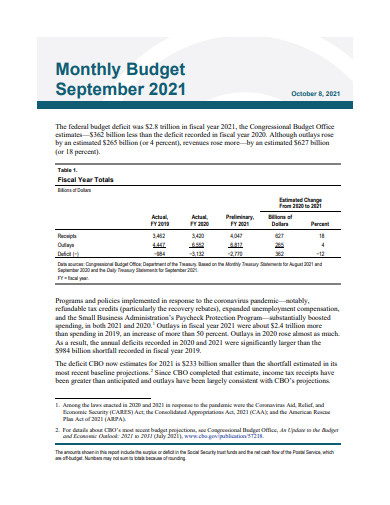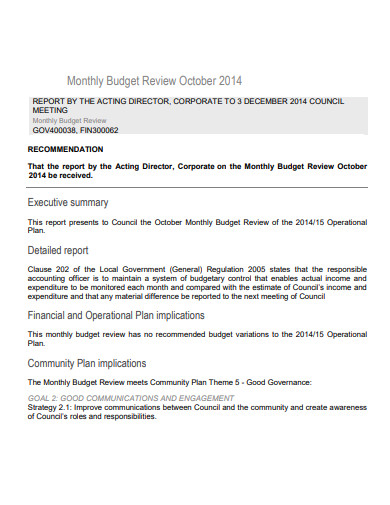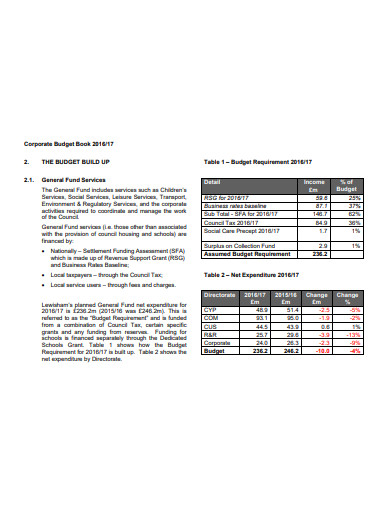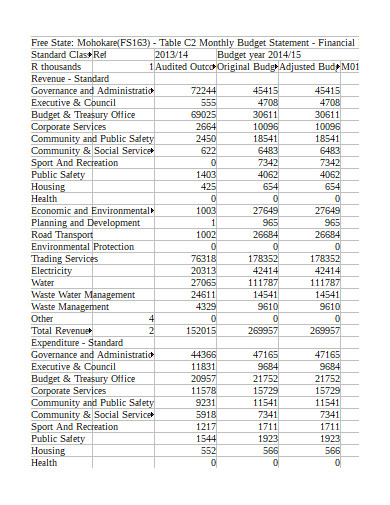4+ Corporate Monthly Budget Samples
Corporate budgeting is an important financial activity, and a solid budget helps a company succeed. Over that time period, the organization’s performance is assessed against the budget using a set of relevant business measures that compare the budget to actual results. Your corporate budget is critical to running your organization and implementing development plans. By aligning the budget with your strategic business strategy, you can ensure that it is always meeting the demands of your company’s goals. Corporate budgeting is set in a timeline, which is why you need all the help you can get. We’ve got you covered! In this article, we provide you with free and ready-made samples of Corporate Monthly Budgets in PDF and DOC format that you could use for your benefit. Keep on reading to find out more!
1. Corporate Monthly Budget
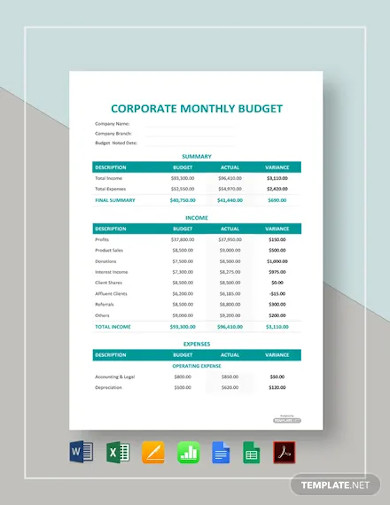
2. Sample Corporate Monthly Budget
3. Simple Corporate Monthly Budget
4. Corporate Monthly Budget Example
5. Basic Corporate Monthly Budget
What Is a Corporate Monthly Budget?
The process through which corporations allocate resources to operations in order to allow their plans is known as corporate monthly budgeting. It’s a revenue and cost plan that also includes the timing of cash inflows and outflows. Debt payments and capital expenditures are also taken into account. Aligning your monthly budget with your company strategy, KPIs, and goal setting is important to success, and the more involved your finance staff is in your business plan, the more natural that alignment becomes.
How to Make a Corporate Monthly Budget
The finest budgets are straightforward and adaptable. Your budget may flex as circumstances change, giving you a clear view of where you stand at all times. A Corporate Monthly Budget Template can help provide you with the framework you need to ensure that you have a well-prepared and robust budget on hand. To do so, you can choose one of our excellent templates listed above. If you want to write it yourself, check out these components below to guide you:
1. The estimated revenue
This is the anticipated profit from the sale of products or services. It’s the total amount of money you bring in the door, regardless of how much you spend to get there. The first line of your budget is this. It might be based on data from the previous year or on industry averages.
2. Fixed costs
Rent, insurance, electricity, bank fees, accounting and legal services, and equipment leasing are all regular, continuous expenditures that don’t fluctuate depending on how much money you make.
3. Variable costs
Raw materials, inventories, production expenses, packing, and shipping are all examples of variable costs. Sales commissions, credit card fees, and travel are all examples of variable expenses. A detailed budget plan lays out how much you estimate to spend on each of these expenses. Salaries can be classified as both fixed and variable costs. Ensure that your various salary expenditures are filed in the appropriate section of your budget.
4. Cash flow
All money flowing into and out of a firm is referred to as cash flow. If more money comes into your organization than goes out over a certain period of time, you have positive cash flow. Because cash flow is the lifeblood of every firm, keep track of it frequently, if not monthly.
5. Profit
After deducting your costs from your earnings, your profit is what you take home. Profits are increasing, which means the company is expanding. Based on your predicted income, costs, and cost of goods sold, this is where you’ll figure out how much profit you’ll make.
FAQ
What are the seven different styles of budgeting?
Strategic plan budget, cash budget, master budget, labor budget, capital budget, finance budget, and operating budget are the seven categories of budgeting utilized by businesses.
What budgets are used by manufacturing firms?
A manufacturing budget is a spreadsheet that shows the expenses of producing a certain number of product units.
What is the primary objective of a budget?
In accounting, the goal of a budget is to develop an accurate financial plan for the future, predicting all sources of revenue and all planned expenditures in order to prevent corporate debt and achieve financial growth.
Making a budget is critical to your long-term prosperity and security. It enables you to monitor and better understand if your company’s revenue is sufficient to cover its costs. To help you get started, download our easily customizable and comprehensive templates of Corporate Monthly Budgets today!
Related Posts
FREE 10+ Expense Budget Samples in MS Word | Google Docs | Google Sheets | MS Excel | PDF
FREE 4+ Vacation Budget Planner Samples in PDF
FREE 10+ Budget Outline Samples in PDF | MS Word
FREE 10+ Conference Budget Samples in MS Word | MS Excel | Google Docs | Google Sheets | Apple Pages | PDF
FREE 10+ Monthly Budget Worksheet Samples in PDF | MS Word | Google Docs | Google Sheets | Excel
FREE 10+ Monthly Project Budget Samples in MS Word | MS Excel | Google Docs | Google Sheets | PDF
FREE 10+ Corporate Budget Samples in MS Word | MS Excel | Google Docs | Google Sheets | PDF
FREE 9+ Primary School Budget Samples in MS Word | Google Docs | Google Sheets | MS Excel | PDF
FREE 10+ Operational Budget Samples in PDF | DOC
FREE 5+ Budget Layout Samples in PDF
FREE 6+ Paycheck Budget Samples in PDF | MS Word
FREE 10+ Architecture Budget Samples in PDF
FREE 10+ Capital Budget Samples in PDF | MS Word | Google Docs | Google Sheets | Excel | Apple Numbers | Apple Pages
FREE 10+ Budget Tracker Samples in PDF | DOC
FREE 10+ Profit and Loss Budget Samples in MS Word | MS Excel | Google Docs | Google Sheets | Apple Pages | PDF

